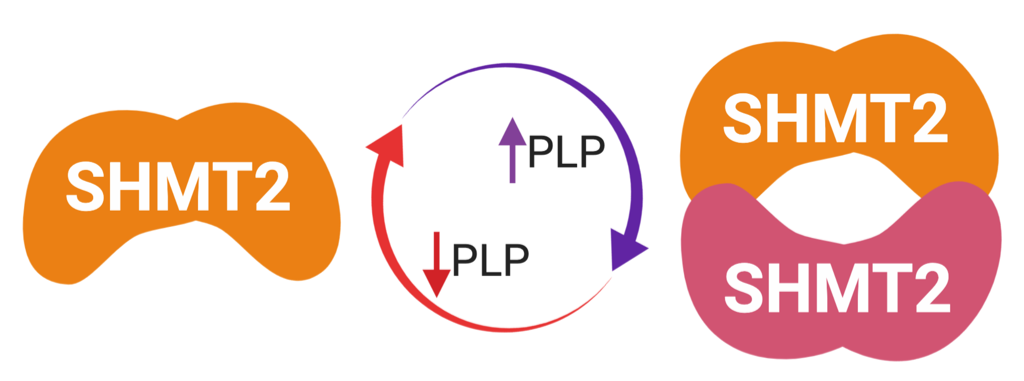21-Sep-2020
Serine hydroxymethyltransferase 2 (SHMT2) is a mitochondrial protein with a critical role in amino acid and nucleotide metabolism – both of which are essential for cell growth and proliferation. In recent years, it has also been postulated that the SHMT2 protein plays a wider role in cell signalling in the cytoplasm. Recent structural biology studies, published by scientists from the Astbury Biostructure Laboratory (Instruct Centre UK), have revealed the structure of a cytoplasmic BRISC-SHMT2 complex, and identified mechanisms by which these proteins regulate signalling within the immune response, with far-reaching implications for our understanding of health and disease.
SHTM2 can exist in two states: an inactive dimer, and an active tetramer when bound to pyridoxal-5’-phosphate (PLP), the active form of vitamin B6.

Figure 1 – The formation of the tetrameric form of SHMT2 upon binding of PLP.
Recent research has uncovered the involvement of SHMT2 in immune response pathways, through intricate complexes formed with other cytoplasmic proteins.
Deubiquitylating BRCC36 isopeptidase complex (BRISC) is a protein that cleaves ubiquitin protein subunits from other proteins (deubiquitylase or DUB activity), although its various biological functions are largely unknown. SHMT2 is known to bind BRISC to form a large protein complex.
Miriam Walden and colleagues have used Cryo-Electron Microscopy (CryoEM) to determine the structure of the human BRISC-SHMT2 complex at a resolution of 3.8 Å. BRISC is arranged as a U-shaped dimer of 4 subunits (BRCC36, BRCC45, ABRAXAS2, MERIT40), and forms a complex with SHMT2 in its inactive dimeric state. Accompanying experiments showed that the active form of SHMT2 (tetramer arrangement bound to PLP) did not bind to BRISC.
Detailed analysis of the interactions between BRISC and SHMT2 showed that SHMT2 blocks the active site of the active BRCC36 subunit within BRISC and inhibits deubiquitylase activity. In addition, a set of mutations were introduced to BRISC to disrupt SHMT2 binding, with the result that type 1 interferon signalling (part of the immune response to inflammatory stimuli) was also interrupted. A final strand of research showed that increasing the levels of intracellular PLP decreased the formation of BRISC-SHMT2 complexes (due to the abundance of PLP-bound SHMT2 tetramers unable to bind to BRISC), reducing interferon signalling. Considered together, these results reveal a direct link between vitamin B6 metabolism and control of immune responses, and a possible mechanism by which vitamin B6 controls BRISC-SHMT2 assembly.
Read the full article: Walden, M., Tian, L., Ross, R. et al. Metabolic control of BRISC–SHMT2 assembly regulates immune signalling. Nature 570, 194–199 (2019) doi:10.1038/s41586-019-1232-1
Find out more about CryoEM facilities at Instruct-ERIC.